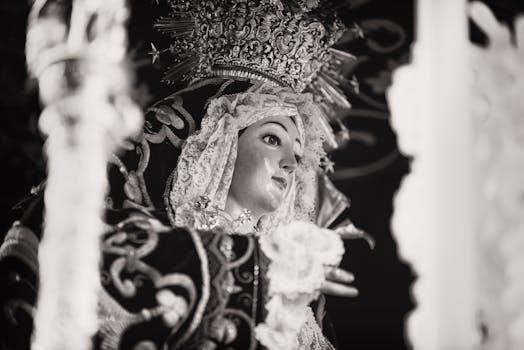Ave Maria in Spanish PDF⁚ A Comprehensive Guide
Explore the profound beauty of the Ave Maria prayer in Spanish. Access downloadable PDF resources, delve into its meaning, and enrich your spiritual devotion to the Virgin Mary.
The Ave Maria, also known as the “Dios Te Salve Maria” in Spanish, is a cherished prayer within the Catholic tradition. It’s a beautiful blend of praise and supplication addressed to the Virgin Mary, the Mother of God. Rooted in biblical texts, specifically the Annunciation and Visitation narratives from the Gospel of Luke, the Ave Maria holds a central place in Catholic devotion. It is an integral part of the Rosary and is often recited individually as a prayer of comfort, hope, and intercession.
This prayer acknowledges Mary’s unique role in salvation history and her special relationship with God. By reciting the Ave Maria, believers seek her maternal guidance and ask for her prayers on their behalf. Understanding the origins and significance of this prayer allows for a deeper appreciation of its power and the comfort it brings to countless individuals around the world.
The Ave Maria Prayer in Spanish
The Spanish version of the Ave Maria, “Dios Te Salve Maria,” holds a special resonance for Spanish-speaking Catholics worldwide. The familiar words, passed down through generations, offer solace and a connection to their faith. Reciting the prayer in Spanish allows for a deeper emotional and spiritual connection for those who find the language closest to their hearts.
The prayer begins with “Dios te salve, María,” a direct address to Mary, acknowledging her grace. It continues, “Llena eres de gracia,” recognizing her as full of divine favor. The inclusion of “El Señor es contigo” reinforces the belief in God’s presence within Mary. The prayer culminates in a plea for her intercession⁚ “Santa María, Madre de Dios, ruega por nosotros, pecadores, ahora y en la hora de nuestra muerte. Amén.” These words represent a powerful request for her assistance in life and at the moment of passing.

Dios Te Salve Maria
“Dios Te Salve Maria” is the Spanish translation of “Hail Mary”. Explore its meaning, significance, and biblical roots within the context of Catholic tradition.
Meaning and Significance of the Prayer
The “Dios Te Salve Maria,” or Hail Mary, holds immense significance within Catholic tradition. It’s a prayer of praise and supplication directed to the Virgin Mary, recognizing her unique role in salvation history. The prayer acknowledges Mary as full of grace and blessed among women, highlighting her purity and divine favor.
The invocation “Madre de Dios” (Mother of God) affirms the central Christian belief in Jesus Christ as both fully God and fully human. Reciting this prayer is an act of entrusting oneself to Mary’s intercession, seeking her maternal guidance and protection. Believers find comfort and strength in her example of faith and obedience to God’s will. The Ave Maria is a core component of the Rosary, a powerful prayer form. The prayer’s simplicity and profound theological depth make it a cornerstone of Catholic devotion, uniting millions in a shared expression of faith.
Biblical Roots of the Ave Maria
The Ave Maria prayer, though a unified prayer, draws its essence from specific passages in the Bible, primarily from the Gospel of Luke. The first part, “Dios te salve, María, llena eres de gracia,” echoes the Angel Gabriel’s greeting to Mary at the Annunciation (Luke 1⁚28). This divine salutation acknowledges Mary’s unique favor with God, proclaiming her to be “full of grace.”
The phrase “Bendita tú eres entre todas las mujeres, y bendito es el fruto de tu vientre, Jesús,” is inspired by Elizabeth’s greeting to Mary during the Visitation (Luke 1⁚42). Elizabeth, filled with the Holy Spirit, recognizes Mary’s blessed status as the Mother of God. These biblical foundations give the Ave Maria its theological weight, grounding it in the narrative of Jesus’s birth and the pivotal role of Mary in God’s plan of salvation. The prayer reflects the early Church’s understanding of Mary’s special place in Christian faith.

Structure and Key Phrases
Explore the Ave Maria’s structure, unveiling key phrases like “Dios te salve, María” and “Santa María, Madre de Dios”. Understand their meaning and significance within the prayer.
“Dios te salve, María” ー God Save You, Mary
The opening phrase, “Dios te salve, María,” translates to “God save you, Mary,” a traditional greeting expressing reverence and respect. It sets the tone for the entire prayer, establishing Mary’s special status within the Catholic faith. This invocation is not merely a salutation; it’s an acknowledgment of Mary’s unique role as the Mother of God and her intercessory power.
The phrase “Dios te salve” is a form of blessing, asking for divine favor upon Mary. It reflects the belief that Mary is blessed among women, a concept rooted in the biblical account of the Annunciation. By uttering these words, devotees express their admiration and seek Mary’s guidance and protection.
In essence, “Dios te salve, María” is a powerful statement of faith, recognizing Mary’s sanctity and her closeness to God. It invites her presence into the prayer and acknowledges her role as a mediator between humanity and the divine.
“Llena eres de gracia” ー Full of Grace
“Llena eres de gracia,” meaning “Full of grace,” highlights Mary’s exceptional state of being, blessed by God in a unique and profound way. This phrase emphasizes that Mary was chosen and prepared to be the Mother of God, imbued with divine grace from the moment of her conception. This fullness of grace signifies her immaculate nature, free from sin, and perfectly aligned with God’s will.
The expression “llena eres” indicates that this grace is not a temporary state but a permanent characteristic of Mary. It underscores her constant communion with God and her role as a vessel of divine favor. This grace empowers her to fulfill her mission as the Mother of Jesus and to intercede on behalf of believers.
By acknowledging Mary as “llena eres de gracia,” the prayer recognizes her pivotal role in salvation history and invites devotees to seek her intercession, trusting in her closeness to God and her ability to obtain divine blessings.
“El Señor es contigo” ― The Lord is with Thee
The phrase “El Señor es contigo,” translated as “The Lord is with Thee,” affirms the divine presence accompanying Mary. This declaration, delivered by the Angel Gabriel, signifies God’s special favor and intimate relationship with Mary. It acknowledges that God chose Mary for a unique purpose and equipped her with His presence to fulfill it.
This divine companionship highlights Mary’s role as the Mother of God, emphasizing that she did not act alone but with the support and guidance of the Almighty. “El Señor es contigo” underscores the power and authority bestowed upon her, enabling her to conceive and nurture the Son of God.
Moreover, this phrase invites believers to recognize God’s presence in their own lives. Just as the Lord was with Mary, He is also with those who seek Him, offering guidance, strength, and comfort. By acknowledging “El Señor es contigo,” the prayer inspires faith and hope, reminding devotees of God’s unwavering presence and support.
“Santa María, Madre de Dios” ― Holy Mary, Mother of God
The invocation “Santa María, Madre de Dios,” meaning “Holy Mary, Mother of God,” is a central affirmation of Mary’s identity and role in salvation history. This title recognizes Mary’s unique status as the woman who bore Jesus Christ, the Son of God, in her womb.
By calling her “Mother of God,” the prayer acknowledges that Jesus is both fully human and fully divine. Mary’s motherhood extends not only to Jesus’ humanity but also to His divinity, solidifying her significance in Christian theology. “Santa María” emphasizes her purity and holiness, underscoring her worthiness to be the Mother of God.
This phrase invites believers to seek Mary’s intercession, recognizing her close relationship with God and her ability to present prayers on their behalf. As the Mother of God, Mary holds a special place in Heaven and is believed to have the power to influence God’s grace. The prayer inspires reverence and devotion, encouraging faithful to turn to Mary for guidance, comfort, and protection.

The Ave Maria in Catholic Devotion
The Ave Maria prayer is a cornerstone of Catholic devotion. It is interwoven into daily prayers, the Rosary, and serves as a powerful supplication to the Virgin Mary.
The Rosary and the Ave Maria
The Rosary, a beloved Catholic devotion, finds its heart in the repeated recitation of the Ave Maria. Each decade of the Rosary centers around a specific mystery in the lives of Jesus and Mary, meditated upon while praying ten Hail Marys.
This repetitive prayer creates a rhythmic cadence, allowing for deeper contemplation of the mysteries. The Ave Maria, in this context, becomes more than just words; it transforms into a vehicle for entering into the sacred narrative. It’s a journey through the Gospels, guided by the gentle intercession of Mary.
The Rosary, therefore, inextricably links devotion to Mary with the central tenets of Christian faith, fostering a closer relationship with both Mother and Son. It’s a tangible way to honor Mary’s role in salvation history, and to seek her guidance in our own lives through the powerful repetition of the Ave Maria.
The Ave Maria as Prayer of Supplication
Beyond its role in the Rosary, the Ave Maria serves as a potent prayer of supplication. Catholics turn to Mary, the Mother of God, seeking her intercession for their needs and the needs of others. The phrase “ruega por nosotros pecadores,” or “pray for us sinners,” encapsulates this plea.
Recognizing our own imperfections and reliance on divine grace, we ask Mary to present our petitions to her Son, Jesus Christ. This act of supplication acknowledges Mary’s unique position as a compassionate advocate, one who understands human frailty and offers solace.
Whether facing personal challenges, seeking healing, or praying for the salvation of souls, the Ave Maria provides a powerful means of expressing our dependence on God’s mercy through the intercession of His Blessed Mother. It’s a heartfelt cry for help, directed towards a source of unwavering love and support.
Variations and Musical Settings
The Ave Maria, a timeless prayer, transcends linguistic and cultural boundaries, manifesting in diverse variations and inspiring countless musical settings. While the core text remains consistent, subtle nuances in phrasing and translation exist across different Spanish-speaking regions, reflecting local traditions and devotional practices.
Moreover, the Ave Maria has served as a wellspring of inspiration for composers throughout history. From the Gregorian chant to soaring operatic interpretations, musicians have captured the prayer’s inherent beauty and spiritual depth in a multitude of styles.
These musical settings enhance the prayer’s emotional impact, allowing individuals to connect with the Ave Maria on a deeper level. Whether sung in a grand cathedral or recited in quiet contemplation, the Ave Maria’s enduring power resonates through its varied expressions, uniting believers in a shared experience of faith and devotion. The musicality enhances the beauty;

Availability of Ave Maria in Spanish PDF Format
Accessing the Ave Maria prayer in Spanish has never been easier, thanks to the widespread availability of PDF resources online. Numerous websites and religious organizations offer free, downloadable versions of the prayer, catering to diverse preferences and needs.
These PDFs often include various formats, such as traditional text layouts, beautifully designed prayer cards, and even versions with accompanying illustrations. Some resources also provide audio recordings of the prayer, enabling users to learn the correct pronunciation and intonation.
The accessibility of Ave Maria in Spanish PDF format empowers individuals to deepen their connection with the prayer, regardless of their location or resources. Whether seeking a simple text version for personal devotion or a visually appealing prayer card for sharing with loved ones, the digital realm provides a wealth of options for engaging with this cherished prayer. Easy access to the format and the illustrations offer a way to engage.